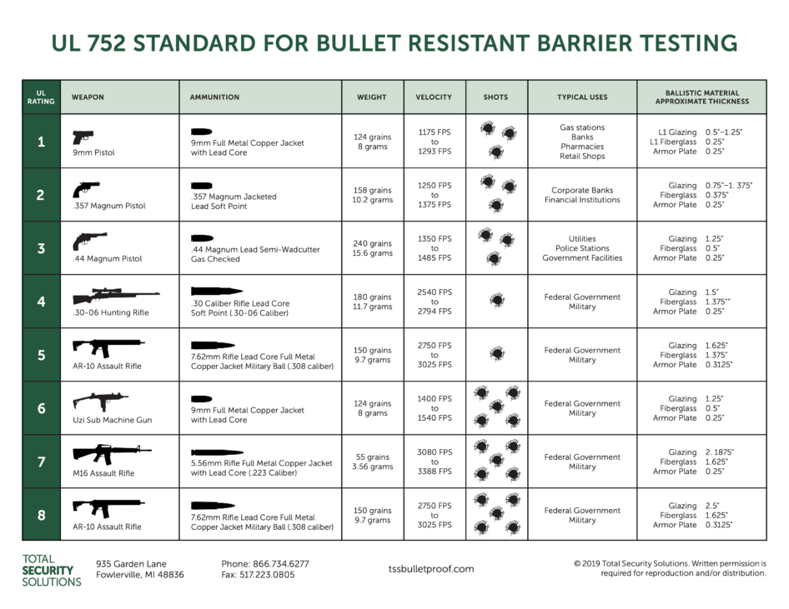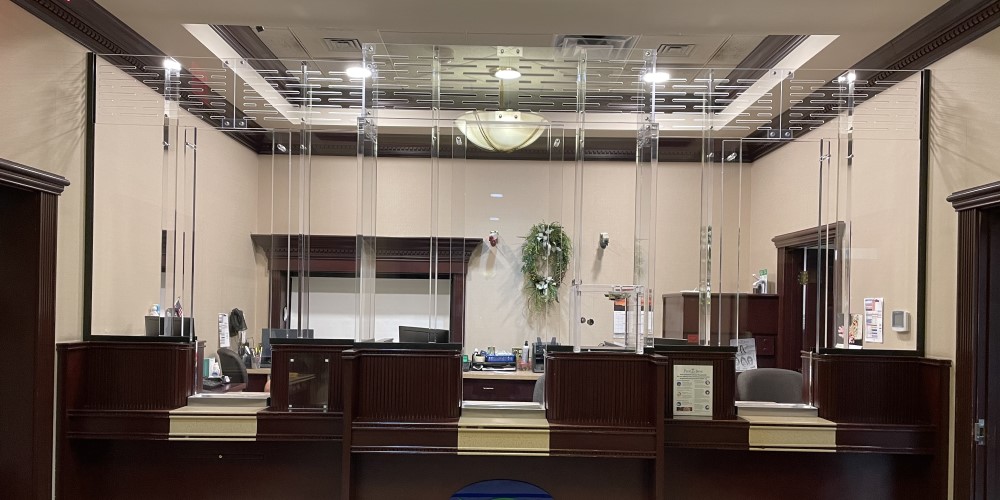As an increasing number of organizations look to improve their physical security, more and more, architects, builders, and even individual contractors and glaziers are being asked:
"What's the right level of bullet-resistance for us?"
While no one can tell a given organization what level of security they need to feel safe and secure, any of us can learn how to guide that conversation so that your clients can make the choice that’s right for them.
The Basics: Understanding Bulletproof Levels
The most important thing to understand is this: No material or component is truly bulletproof.
“Bulletproof” is really just a colloquial term. People use it for everything from coffee-based diets to rugged coatings for your truck bed.
Ballistic building materials are bullet-resistant. They are lab tested against the UL 752 “Standard for Bullet-Resisting Equipment.” A given “bulletproof material” or component is rated 1 through 8. In broad terms, materials rated Levels 3 and below stop clusters of bullets fired from pistols, while those rated Levels 4 and above stop one or more bullets from various rifles as well as any pistols.
There are several commonly used rating systems for choosing bullet-resistant materials in commercial construction. We've referenced the "UL system" here because UL-rated materials are favored (or, in many cases, mandatory) in building construction. You may also see manufacturers refer to "NIJ ratings" (a system used by the National Institute for Justice, largely for body armor). Use caution with NIJ-rated materials, as there is some confusion around the difference between materials that “meet the requirements of NIJ Standards" versus those that are “NIJ Compliant.” Meanwhile, there is no confusion around "UL-rated materials": if a manufacturer says that material, component, or system is UL-rated, then they will be able to produce a report from a third-party testing lab confirming that this item conformed to that specific bulletproof level for which it is rated.
You may also come across ASTM standards. These are more common when you need to meet certain complex building requirements or evaluate interactions of factors, like extreme weather, blast-resistance, and different modes of forced entry. (See our full explainer on popular bulletproof level standards for more details.)
Planning a Bullet-Resistant Barrier System in Five Steps
Total Security Solutions has decades of experience designing, engineering, fabricating, and installing custom bullet-resistant barrier systems. Over the years, Total Security Solutions has developed a five-step approach that architects and builders can use to assess a new project.
Step 1: Consider the End-Users' Needs and Goals
Ideally, planning a bullet-resistant barrier system should be an outgrowth of the facility's end-users' "all-hazards" approach to ensuring their staff and visitors are safe and secure. Such a planning process will have already helped them formulate their various safety and security plans, and set specific goals. These might range from simply evacuating the building with as little harm to occupants as possible, or extend to encompass their continuity-of-operations and recovery planning.
In terms of choosing bullet-resistant materials for this project, what's most important is to identify what specific security features need to be "baked in" to the building itself: windows, doors, package passers, access control systems, and so on.
But this step shouldn't be limited to security concerns. Take time to understand their operational needs: what are their high- and low-traffic periods like? Do they need to screen visitors, scan IDs, or check credentials? Do they accept packages? Exchange paperwork, files, or bulky items? Is the reception area noisy or exposed to inclement weather or susceptible to seasonal issues? Will installing a bullet-resistant barrier hinder the proper operation of an HVAC system?
A bullet-resistant barrier is useless if staff can't see out fogged windows, prop the doors open because it's 90º behind the barrier when the afternoon sun shines, or otherwise create ways around the barrier because it has become a barrier to their doing their jobs.
Step 2: Determine the Threat Level
The end-users’ all-hazards planning should likewise help them identify specific threats and risk factors. Be especially aware of industry or operations-specific threats. For example, banks are obviously a target for armed robbery, whereas city offices might be facing specific known threats from anti-government groups. Meanwhile, schools are especially exposed to issues around domestic violence and non-custodial adults’ attempting to make contact with children. All of these require different approaches to creating a physical barrier.
Similarly, does the surrounding environment or community affect the threat level? Factors here might include historic crime levels, access to freeways, the building's position relative to major intersections, visibility, urban/suburban/exurban/rural community factors, and more.
Step 3: Design with Functionality and Aesthetics in Mind
The functionality of a bullet-resistant barrier system goes beyond simply stopping bullets. It also must permit good communication across the barrier, allow for good visibility to assess and prepare for potential threats and make it possible to easily pass papers or packages.
One key aspect of functionality is aesthetics. An ugly barrier, or even just one that draws attention to itself, creates obstacles. Designers experienced with ballistic materials and bullet-resistant systems have strategies to ensure the barrier blends with the existing aesthetics and decor. The goal is to be sure staff don't feel caged in, visitors don't feel shut out, and everyone feels secure.
Maintenance is another consideration when choosing bullet-resistant materials. Depending on the building's usage and traffic patterns, some materials will be easier to maintain than others. For example, common spray-on cleaners can damage some ballistic glazing. This is because the cleaners contain aromatic solvents that highlight the stresses within the material. This results in a permanent deep “fogging” or haze in the glass, called “crazing.” (Glasses wearers may be familiar with this phenomenon, as it also happens to eyeglass lenses if they are improperly cleaned with rubbing alcohol. Like eyeglasses, ballistic windows should always be cleaned with a soft cloth, mild soap, and water.)
Similarly, the anti-glare and other surface coatings on some bullet-resistant windows can be scratched by frequent contact, giving windows a dull, hazy appearance. Many schools will choose to install glass-clad polycarbonate because its surface is extremely durable. As Bob George, a senior consultant with Total Security Solutions has pointed out, “In a high-traffic area in a high school, a thousand kids are going to put their hands on those doors every day. A glass-clad product is going to stay looking good much longer, because of the hardness of that glass outer layer.”
Step 4: Select Materials Appropriate to the Threat Level and Building Design
You're now ready to work with the end user in selecting the appropriate bullet-resistant materials. These might include bullet-resistant glazing, framing, fiberglass wall reinforcements, as well as complete components like doors and transaction windows.
Every element should be rated at the appropriate UL (or other) bulletproof level. Make sure the materials have been properly certified by a third-party lab.
If you’re not confident making these decisions, make some general selections (styles of doors, window sizes, etc.) and reach out to a bullet-resistant barrier specialist like TSS. Through decades of experience, TSS has created countless solutions to blend a ballistic barrier into an existing aesthetic. They’ve developed a knack for choosing components like glazing, wall panels, doors, framing, voice ports, deal trays, and package passers, that work with the space they will inhabit. They’ve also distinguished themselves in being able to work with and preserve the character of historic interiors.
Step 5: Consult an Expert for Complex Challenges
Architects and builders often run up against physical limitations to installing the barrier system the end user wants. Common physical limitations include the location of the barrier within a building, getting materials to that location, working around odd ceiling heights or historic fixtures, or dealing with local building ordinances.
For example, builders looking to replace upper-story exterior windows may not appreciate the significant weight of large sheets of ballistic glazing. Installing such exterior windows might require riggers, cranes, street and office closures, special permits, and coordinating with multiple city agencies and services. It's an expensive proposition.
TSS has developed custom glazing solutions that easily cut 25% of the cost of such a project.
According to TSS CEO Jim Richards, "You go from closing down the street for a full business day to maybe moving a few desks before you leave for the night. It would be hard to overstate what a difference it makes" to work with an expert early in the process.
Learn More About Bulletproof Security with TSS
"There’s always been a need to increase security without changing the look and feel and facade of an existing building," Jim says. "But … in the past, the industry was content to just cobble things together or give half a solution: it stops bullets, but looks clunky; it looks good, but it's hard to maintain; it looks great, but it costs a fortune."
TSS uses their decades of experience to bring together good solutions that are flexible, architectural, and meet everyone's needs.
Ready to learn more about how you can help your clients improve their bulletproof security? TSS offers an AIA-approved continuing education course “8 Levels of Bullet-Resistant Materials Explained” hosted on AEC Daily. Have more specific questions about a project you’re working on now? Contact one of TSS’s ballistic security experts today.

